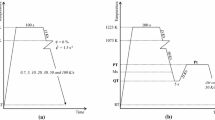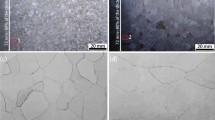Abstract
Herein, the effects of microstructure on high-temperature properties (hot ductility and stress rupture life) were investigated in alloy 718 investment castings manufactured with different Si contents (0.051, 0.11, and 0.17 wt pct) and different cooling rates (0.52 °C/s and 1.65 °C/s). For the casting with a low cooling rate, an additional solution treatment step was added to the standard pre-weld heat treatment. Even small amounts of residual Laves phase (0.14 to 0.35 wt pct) adversely affected both the hot ductility and stress rupture properties. Hot ductility tests indicated that the presence of Laves phase led to an earlier decrease in hot ductility in on-heating tests and retarded ductility recovery in on-cooling tests. Both effects are usually associated with poorer weldability and greater hot cracking susceptibility. Ductility recovery was also affected by grain size and aspect ratio: columnar and smaller grain sizes showed better ductility recovery behavior. Stress rupture tests indicated that stress rupture life and elongation decreased with increasing Si content, due to the presence of a semicontinuous network of Laves phase at grain boundaries instead of intergranular δ phases. This effect was much more pronounced in stress rupture than in hot ductility tests. The presence of residual Laves phase was associated with higher Si content and lower cooling rates. The additional solution treatment step of 2 hours at 1052 °C did not eliminate the Laves phase completely.













Similar content being viewed by others
References
M.J. Donachie and S.J. Donachie: Superalloys: A Technical Guide, 2nd ed. ASM International, Novelty, OH, 2002, pp. 1–38.
J.F. Radavich: Superalloy 718-Metallurgy and Applications, The Minerals, Metals & Materials Society, Warrendale, PA, 1989, pp. 229–40.
X. Liang, R. Zhang, Y. Yang, and Y. Han: Superalloys 718, 625, 706 and Various Derivatives, The Minerals Metals & Materials Society, Warrendale, PA, 1994, pp. 947–56.
Z.J. Miao, A.D. Shan, Y.B. Wu, J. Lu, W.L. Xu, and H.W. Song: Trans. Nonferrous Met. Soc. China, 2011, vol. 21, pp. 1009–017.
W.D. Cao, R.L. Kennedy, and M.P. Willis: Superalloys 718, 625, and Various Derivative, Metals and Materials Society, Warrendale, PA, The Minerals, 1991, pp. 147–60.
B.G. Muralidharan, V. Shankar, and T.P.S. Gill: Weldability of Inconel 718-A Review, Indira Gandhi Centre for Atomic Research, Kalpakkam, Tamil Nadu, 1996.
R.G. Thompson and S. Genculu: Weld. J., 1983, vol. 62, pp. 337–45.
S. Singh and J. Andersson: Sci. Technol. Weld. Join., 2018, vol. 23, pp. 568–74.
S. Singh, F. Hanning, and J. Andersson: Metall. Mater. Trans. A, 2020, vol. 51A, pp. 6248–257.
J. Andersson, G.P. Sjöberg, L. Viskari, and M.C. Chaturvedi: Mater. Sci. Technol., 2012, vol. 28, pp. 609–19.
J. Andersson, G.P. Sjöberg, L. Viskari, and M. Chaturvedi: Mater. Sci. Technol., 2012, vol. 28, pp. 733–41.
S. Singh, F. Hanning, and J. Andersson: Mater. Sci. Eng. A, 2021, vol. 799, p. 140151.
S. Guo, W. Sun, D. Lu, and Z. Hu: Superalloys 718, 625, 706 and Various Derivatives, The Minerals, Metals & Materials Society, Warrendale, PA, 1997, pp. 521–30.
J.J. Schirra, R.H. Caless, and R.W. Hatala: Superalloys 718, 625 and Various Derivatives, The Minerals, Metals & Materials Society, Warrendale, PA, 1991, pp. 375–88.
E. Hosseini and V.A. Popovich: Addit. Manuf., 2019, vol. 30, p. 100877.
V.A. Popovich, E.V. Borisov, V. Heurtebise, T. Riemslag, A.A. Popovich, and V.S. Sufiiarov: TMS 147th Annual Meeting & Exhibition Supplemental Proceedings, Springer, Cham, 2018, pp. 85–97.
S. Sui, H. Tan, J. Chen, C. Zhong, Z. Li, W. Fan, A. Gasser, and W. Huang: Acta Mater., 2019, vol. 164, pp. 413–27.
P. Álvarez, A. Cobos, L. Vázquez, N. Ruiz, P.P. Rodríguez, A. Magaña, A. Niklas, and F. Santos: Metals, 2021, vol. 11, p. 402.
J.J. Schirra: Superalloys 718, 625, 706 and Various Derivatives, The Minerals, Metals & Materials Society, Warrendale, PA, 1997, pp. 439–66.
ISO/TR 17641-3:2005(E) Destructive Tests on Welds in Metallic Materials-Hot Cracking Tests for Weldments-Arc Welding Processes-Part 3: Externally Loaded Tests, International Organization for Standardization (ISO), Geneva, 2005.
R.G. Thompson, J.R. Dobbs, and D.E. Mayo: Weld. J., 1986, vol. 65, pp. 299–304.
J.N. DuPont, J.C. Lippold, and S.D. Kiser: Welding Metallurgy and Weldability of Nickel-Base Alloys, Wiley, Hoboken, NJ, 2009.
W.A. Baeslack III. and D.E. Nelson: Metallography, 1986, vol. 19, pp. 371–79.
I. Woo, K. Nishimoto, K. Tanaka, and M. Shirai: Weld. Int., 2000, vol. 14, pp. 514–22.
S. Benhadad, N.L. Richards, and M.C. Chaturvedi: Metall. Mater. Trans. A, 2002, vol. 33A, pp. 2005–017.
L. Shuqi, Z. Jingyun, Y. Jinyan, Q. Deng, and J. Du: Superalloys 718, 625, 706 and Various Derivatives, The Minerals, Metals & Materials Society, Warrendale, PA, 1994, pp. 545–5.
G. Sjoberg and N.G. Ingesten: Superalloys 718, 625 and Various Derivatives, The Minerals, Metals & Materials Society, Warrendale, PA, 1991, pp. 603–20.
D.-W. Han, L.-X. Yu, F. Liu, B. Zhang, and W.-R. Sun: Metall. Sin. (Engl. Lett.), 2018, vol. 31, pp. 1224–32.
M.G. Burke and M.K. Miller: Superalloys 718, 625 and Various Derivatives, The Minerals, Metals & Materials Society, Warrendale, PA, 1991, pp. 337–50.
Acknowledgments
This research was performed partially under the framework of the HiperTURB project, which was funded by the Clean Sky 2 Joint Undertaking under the European Union’s Horizon 2020 research and innovation program, Grant Agreement No. 755561. Bengt Pettersson and Vikström Fredrik from the GKN Aerospace company in Trollhättan (Sweden) are gratefully acknowledged for their technical support and fruitful discussions. Additionally, the authors thank Kejll Hurtig and Joel Andersson (Department of Engineering Science at West University) for support in performing hot ductility tests. This study was completed with financial support from the Basque Government (Project: CEMAP: Desarrollo de Materiales Cerámicos y Metálicos de Altas Prestaciones para Fabricación Avanzada, ELKARTEK KK-2020/00047 and MINERVA: ELKARTEK KK-2022/00082).
Author Contributions
AN contributed to investigation of stress rupture tests, methodology, formal analysis, and writing—original draft preparation. RGM contributed to investigation of stress rupture tests, and microstructural investigation and visualization. FS contributed to conceptualization, methodology, supervision, writing—review and editing, project administration, and funding acquisition. PPR contributed conceptualization, methodology, investigation in investment casting, and writing—review. AC contributed to investigation of hot ductility tests, microstructural investigation, and visualization. DB contributed to DSC measurements. LV contributed to investigation of hot ductility tests, methodology, data curation, and visualization. PÁ contributed to investigation of hot ductility, methodology, formal analysis, and writing—original draft preparation. All authors have read and agreed to the published version of the manuscript.
Conflict of interest
The authors declare that they have no known competing financial interests or personal relationships that could have appeared to influence the work reported herein.
Author information
Authors and Affiliations
Corresponding author
Additional information
Publisher's Note
Springer Nature remains neutral with regard to jurisdictional claims in published maps and institutional affiliations.
Rights and permissions
Springer Nature or its licensor (e.g. a society or other partner) holds exclusive rights to this article under a publishing agreement with the author(s) or other rightsholder(s); author self-archiving of the accepted manuscript version of this article is solely governed by the terms of such publishing agreement and applicable law.
About this article
Cite this article
Niklas, A., Santos, F., Gonzalez-Martinez, R. et al. Effects of Different Si Content and Thermal Stories on the Secondary Phase Formation, Hot Ductility, and Stress Rupture Properties of Alloy 718 Investment Castings. Metall Mater Trans A 54, 2670–2688 (2023). https://doi.org/10.1007/s11661-023-07046-4
Received:
Accepted:
Published:
Issue Date:
DOI: https://doi.org/10.1007/s11661-023-07046-4




